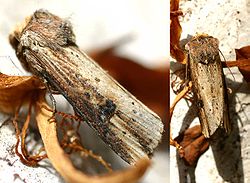| Flame | |
|---|---|
 | |
| Scientific classification | |
| Kingdom: | Animalia |
| Phylum: | Arthropoda |
| Class: | Insecta |
| Order: | Lepidoptera |
| Superfamily: | Noctuoidea |
| Family: | Noctuidae |
| Genus: | Axylia |
| Species: | A. putris |
| Binomial name | |
| Axylia putris (Linnaeus, 1761) | |
The flame (Axylia putris) is a moth of the family Noctuidae. It is found throughout Europe then east across the Palearctic to Armenia, western Siberia and Amur, Korea and Japan. The range extends into northern India.
Contents
This species has creamy-buff forewings (sometimes tinged with red) with black streaking along the costa. The hindwings are whitish with a dark line along the margin. The wingspan is 30–36 mm. Unusually for a noctuid, this moth rests with its wings wrapped tightly around its body making it resemble a broken twig. It flies at night in June and July (sometimes a second brood is produced which flies in September) and is attracted to light.


